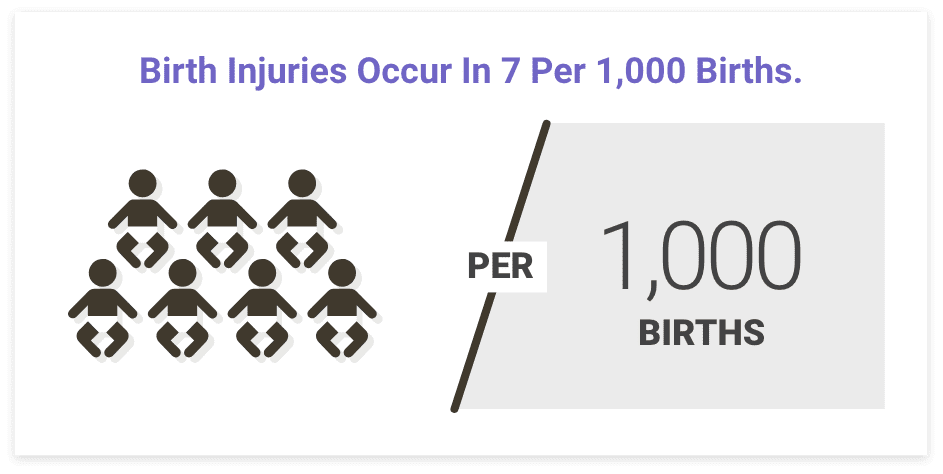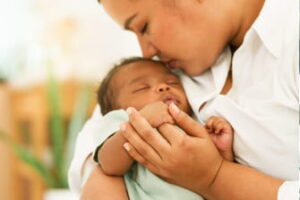
Top Birth Injury Statistics
Many birth injuries can impact a child, including brain damage, cerebral palsy, Erb’s palsy, and more.
Knowing the facts about birth injury statistics can help you make more informed decisions regarding the health of your child.
- Most common birth injury: A fractured collarbone, according to Stanford Children’s Health. These fractures occur in as many as 15 out of 1,000 live births.
- Most common childhood motor disability: Cerebral palsy, which is often linked to birth injury brain damage. According to the CDC, cerebral palsy occurs in 1.5 to 4 children per every 1,000 births.
- One of the most common birth injuries leading to long-term effects: Erb’s palsy, which limits the use of the arm, shoulder, and hand. Approximately 12,000 babies born each year develop Erb’s palsy due to an injury at birth, according to Cleveland Clinic.
- Common risk factors for birth injuries: Genetic, environmental, and socioeconomic factors, along with medical malpractice by doctors and hospital staff.
If your baby was harmed due to medical malpractice, a birth injury lawyer may be able to help you pursue compensation for medical bills, treatment, and more. Contact us for a free case review today.
Statistics on Birth Injury Causes
There are many causes of birth injuries. Here are some key birth injury statistics and the leading reasons they occur.
Delayed Birth
About 8% of women experience delayed birth, also called prolonged labor. Risk factors for a delayed birth include a high body mass index or gaining significant weight during pregnancy.
A delayed birth can also make it difficult for infants to move through the birth canal. As a result, they can suffer nerve or muscle damage.
Improper Use of Delivery Tools
 Doctors may sometimes rely on assistive tools to help deliver babies. Sadly, birth injury statistics show that vacuum extraction and forceps delivery complications sometimes cause severe harm to newborns.
Doctors may sometimes rely on assistive tools to help deliver babies. Sadly, birth injury statistics show that vacuum extraction and forceps delivery complications sometimes cause severe harm to newborns.
For example, vacuum extractor complications include subgaleal hemorrhage (a life-threatening brain bleed) in .6% of cases. Brain bleeds can lead to severe infections, other brain injuries, and infant deaths.
Monitoring and Delivery Issues
Failure to catch severe health problems before birth is another type of medical malpractice. Physicians sometimes fail to monitor expectant mothers correctly, missing potentially severe complications that can lead to different kinds of birth injuries.
In an insurance company study, 40% of birth injury liability claims involved poor management of labor and delivery. Most of these claims were made when a vaginal birth, as opposed to a cesarean section (C-section), proved harmful for both the mother and the baby.
Oxygen Deprivation
A lack of oxygen at birth can damage a baby’s brain, leading to severe conditions like cerebral palsy, hypoxic-ischemic encephalopathy (HIE), or even infant death.
About 2 of every 1,000 infants suffer oxygen deprivation, according to the University of Oxford.
If any of these situations occurred when you gave birth to your child, you may have unanswered questions.
Contact us today to speak with our compassionate labor and delivery nurses. They can provide the support and guidance you need in confidence.
Statistics on Birth Injury Risk Factors
Any child can be born with a birth injury. That said, some factors increase the odds of a birth injury and affect overall birth injury statistics. Risk factors for birth injuries include the following.
Exposure to Toxins
Toxins such as methylmercury are extremely dangerous for expectant mothers, as they can damage the developing brain of the newborn child. One of the most common ways people can be exposed to methylmercury is by eating fish contaminated with it.
Exposure to harmful medications can also cause infant injury. The blood-placental barrier filters what moves from the mother’s bloodstream to the infant’s bloodstream.
Medications during pregnancy are sorted into categories based on safety for the fetus: Category A (safest), B, C, D, and X (most risky), considering their ability to cross this barrier. Doctors must ensure prescribed medications during pregnancy are safe, falling under Category A or B.
Low Birth Weight


A low birth weight puts infants at greater risk of problems during delivery. The percentage of babies born prematurely or with low birth weight is estimated to be increasing in the United States.
Physical Trauma
Physical trauma, such as excessive force from a doctor during a vaginal delivery, can cause severe damage to a newborn’s head, neck, and shoulders. This damage can lead to developmental delays, brain damage, or nerve injuries like Erb’s palsy.
Premature Births
An estimated 9.8% of all newborns are preterm births. Children born before the 37th week of pregnancy have a higher risk of birth injury because their brains, muscles, and nervous systems have not yet fully developed.
For example, premature babies are more likely to develop a gastrointestinal infection called necrotizing enterocolitis (NEC).
Cerebral Palsy Statistics


Scope of Cerebral Palsy in the United States
About 3 out of 1,000 children have cerebral palsy in the United States, according to the CDC.
Cerebral palsy that originates at birth, also known as congenital CP, makes up 85-90% of all cases, according to the CDC. CP affects boys more often than girls.
Nearly 1 million people in the United States are living with cerebral palsy. Further, the Cerebral Palsy Alliance Research Foundation (CPARF) notes that approximately 17 million people worldwide live with some form of CP.
Statistics on Cerebral Palsy Risk Factors
Maternal health, infant health, and socioeconomic status are all significant risk factors for CP. Here is a brief look at some of the data associated with these risk factors.
Infant Health at Birth
Newborn babies with illnesses that affect brain development are at an increased risk for CP. One example is jaundice, which affects 60-80% of newborns.
When left untreated, severe jaundice can cause kernicterus, a rare but dangerous type of brain damage. Kernicterus impacts about 1 of every 44,000 newborns from developed countries.
Initial treatment of jaundice is placing the infant under direct phototherapy lights (bright UV lights). This therapy helps to break down bilirubin so the infant can pass it more efficiently and quickly through their stool. IV treatments and blood transfusions are rare but can be needed for jaundice treatment to prevent kernicterus from developing.
Maternal Infection


Socioeconomic Status
According to one study, 30% of CP cases can be traced to economic inequality. The study’s authors believe pregnant women with lower incomes may not have access to quality prenatal health care.
If you believe your child’s birth injury led them to develop CP, speak with one of our registered nurses to learn what you can do next.
Statistics on Cerebral Palsy Types
There are five main types of CP: spastic, dyskinetic, ataxic, hypotonic, and mixed.
- Spastic cerebral palsy is the most common type of the condition. It appears in 70-80% of all people diagnosed with cerebral palsy, according to CPARF. It causes extreme muscle tension and can lead to paralysis in two limbs, all four limbs, or half the body.
- Dyskinetic CP leads to random body movements and occurs in 5-20% of those diagnosed with CP.
- Ataxic CP makes walking very difficult and affects other motor skills as well. It occurs in 5-10% of all people with cerebral palsy.
- Hypotonic CP causes floppy muscles (hypotonia) and is one of the rarest types of CP, accounting for 2.6% of all cases.
- Mixed CP is a combination of at least two other types of CP caused by damage to multiple areas of the brain. Around 15% of all people with CP are diagnosed with this type.
Cerebral Palsy Treatment Statistics
There are no known cures for cerebral palsy at this time. Fortunately, some approaches show promise in treating CP. Here are just a few.
Medications
Certain medications to help reduce spasticity or improve movement have shown to be effective in helping address the symptoms of CP. Some of these CP medications include diazepam (for muscle spasms), baclofen (relaxes muscles and treats pain from muscle stiffness), and botulinum toxin type A (to help muscle spasms).
Physical Therapy
Physical therapy (PT) attempts to improve motor functions. It typically includes exercises to increase the range of motion, strengthen muscles, and improve balance. According to one study, PT can increase a child’s mobility by as much as 13%.
Surgery
Many surgeries can treat the symptoms of CP and improve mobility. One procedure, known as dorsal rhizotomy, has been shown to be effective for some people suffering from CP.
One analysis showed significant improvements in up to 70% of patients. The procedure involves the removal of a thin layer of bone, as well as some nerves, from the spine. The goal of this surgery is to reduce muscle tightness and muscle spasms that are common with CP.
Birth Injury Statistics on CP and Co-Occurring Conditions
Many medical conditions go hand in hand with birth injuries. These issues affect different parts of a person’s mobility, speech, and mental abilities.
When a child has another condition besides cerebral palsy, it is known as a co-occurring condition.
- 1 in 2 children born with cerebral palsy will also have an intellectual disability
- 1 in 3 will have extremely limited or no walking ability
- 1 in 4 will be unable to speak
- 1 in 4 will have epilepsy and accompanying seizures
- 1 in 4 will have bladder control problems
- 1 in 5 will have a sleep disorder
- 3 in 4 will experience lifelong, chronic pain
- 1 in 10 will have notable vision issues
Erb’s Palsy Statistics
Erb’s palsy is an injury that affects the brachial plexus. This grouping of nerves extends from the neck through the shoulders and arms. Any damage to the brachial plexus can result in severe weakness. Those with severe Erb’s palsy won’t be able to use the affected arm without treatment.
Scope of Erb’s Palsy in the United States
Erb’s palsy occurs in approximately 1-3 of every 1,000 births in the United States, making it the most common type of brachial plexus injury.
Statistics on Erb’s Palsy Risk Factors
Several risk factors can increase a child’s chances of developing Erb’s palsy.
Shoulder Dystocia
The most common risk factor for Erb’s palsy is shoulder dystocia, where one or both of the baby’s shoulders gets caught in the mother’s pelvis during delivery. Brachial plexus injury occurs in about 1-20% of shoulder dystocia birth injury cases.
When shoulder dystocia injures a baby’s brachial plexus nerves, it can cause Erb’s palsy.
Use of Forceps or Vacuum Extractor During Delivery
Another risk factor for Erb’s palsy is using forceps or a vacuum extractor during delivery. Improper use of these delivery tools can increase the risk of a clavicle (collarbone) fracture.
Researchers conducting a study of more than 11,000 deliveries found that 53% of infants whose collarbones were fractured during the birthing process also developed Erb’s palsy.
The same researchers found that the risk of Erb’s palsy declined substantially among children born through a C-section.
Erb’s Palsy Treatment Statistics
Unlike cerebral palsy, Erb’s palsy is curable in many cases. Approximately 67% of babies recover fully from Erb’s palsy without needing treatment. Further, if treatment starts within a month after birth, the recovery rate increases to nearly 100%.
Treatment for Erb’s palsy usually involves some physical therapy, which leads to significant improvement in nearly 95% of cases.
However, if this approach does not work, a surgical procedure like a nerve graft or muscle transfer may be needed. Approximately 50% of Erb’s palsy surgeries are successful.
Other Brachial Plexus Injury Statistics
In addition to Erb’s palsy, there are other types of brachial plexus injuries: extended Erb’s palsy, Klumpke’s palsy, and total plexus involvement. Some brachial plexus injuries mimic spinal cord injuries with the scope of the damage.
- Erb’s palsy: Erb’s palsy accounts for 45-50% of all brachial plexus palsy cases. It is associated with damage to the nerves at the C5 to C6 sections of the spine.
- Extended Erb’s palsy: This form typically affects the lower portion of the brachial plexus (the C7 section of the spine). It makes up an estimated 20% of brachial plexus injuries.
- Klumpke’s palsy: The rarest type, it accounts for less than 1% of brachial plexus injuries. It involves damage to the C8 to T1 sections of the spine. Damage is typically limited to the muscles of the forearm and hand.
- Total plexus involvement: This devastating birth injury damages all of the muscles in the shoulder, arm, hand, and fingers. It accounts for about 35% of brachial plexus injuries. Total plexus involvement affects nerves between the C5 and T1 sections of the spine.
Brachial plexus birth injuries are categorized according to the type of nerve injury and the pattern of nerves involved:
- Avulsion (10-20% of injuries)
- Neuroma
- Neuropraxia (most common)
- Ruptures
Statistics on the Cost of Birth Injuries
Birth injuries that lead to cerebral palsy, Erb’s palsy, and other serious health conditions can create financial hardships for many families.
Not only are treatment costs high, but parents may need to make special accommodations to their home to help their child live as normal a life as possible. They may also need to quit their jobs, reduce their hours, or miss work to provide care.
- It can cost 10 times as much to care for a child with CP than for one who does not have the condition.
- When a child has CP and an intellectual disability, the costs can be 26 times as high.
However, some families may be able to access compensation to help reduce the financial burden. If your child’s injury resulted from medical negligence, you may be able to file a birth injury lawsuit.
Statistics on Birth Injury Legal Claims
Sometimes, when babies are injured during birth, families have legal options. Legal claims can provide much-needed compensation for medical bills and other damages related to injuries caused by medical negligence.
Personal injury law firms can help families seek compensation for brain damage, skull fractures, and other injuries that could have been avoided.
Birth Injury Statistics: Learn More and Get Legal Help
These birth injury statistics help show you are not alone in facing the challenges that come along with caring for your child.
Further, understanding birth injury statistics and knowing what steps to take when mistakes were made might lead you to consider seeking compensation through a birth injury lawsuit.
To learn more about your legal options or schedule a free case review, call us today at (800) 914-1562.
Birth Injury Statistics FAQs
What are the most common birth injuries?
According to birth injury statistics, here are some of the most common types:
- Bone fractures: Sometimes, the pressure during birth can break the baby’s delicate bones, especially the collarbone.
- Brachial plexus injuries: The network of nerves that control arm and hand movement can get damaged during a difficult delivery, causing weakness, limited motion, or pain. Erb’s palsy is a common form.
- Cerebral palsy: CP is a lifelong disability caused by brain damage that can happen during birth. The condition causes problems with movement and coordination.
- Forceps or vacuum extractor injuries: Health care professionals sometimes use these assistive devices to help with a difficult delivery. Improper use or excessive force can lead to bruising, cuts, swelling, and even brain damage.
- Hypoxic-ischemic encephalopathy (HIE): When a baby’s brain doesn’t get enough oxygen, it can lead to long-term difficulties with movement, thinking, and learning.
How common are birth injuries to mothers?
Birth injuries to mothers are not very common compared to birth injuries to babies. Medical advancements have reduced the chances of severe injuries. However, complications like tailbone injury, tears, or bleeding can still happen.
What is the #1 complication of childbirth?
There are no concrete birth injury statistics to accurately rank the #1 complication of childbirth. However, one of the most common complications is labor that does not progress.
Unfortunately, stalled labor increases the risk of birth injuries. When babies get physically stuck in the birth canal, it can sometimes damage their nerves or muscles.
Additionally, doctors may use tools like forceps or vacuum extractors to assist in the delivery. However, using these tools can sometimes lead to injuries in the baby’s nerves or muscles, which can harm their health.
Factors such as first-time pregnancies, maternal age over 35, high birth weight, abnormal baby position, and weak contractions contribute to delayed labor.




